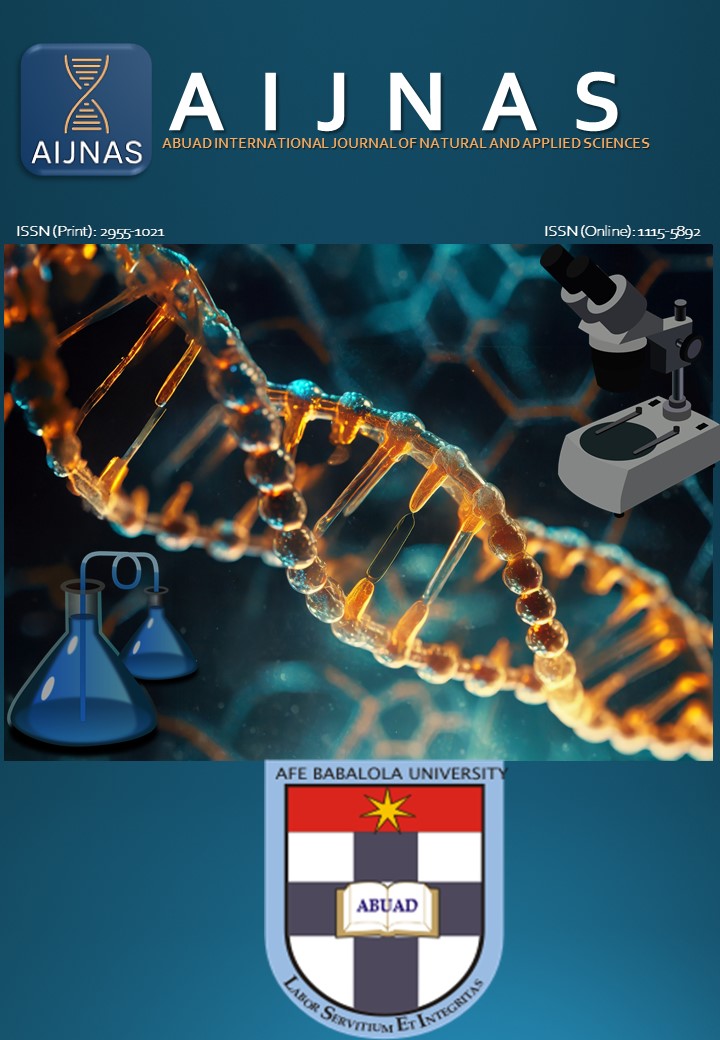CONSUMER’S ACCEPTABILITY OF YOGHURT STABILIZED WITH PUMPKIN (Curcubita pepo L.) STARCH
Main Article Content
Abstract
This research was carried out to determine the possibility of adding pumpkin starch to yoghurt production to improve its physical and sensory properties. Pumpkin yoghurt was made with pumpkin starch at 0% and 1% inclusion, while commercial yoghurt was used as a control and was evaluated by thirty (30) untrained panelists on taste, aroma, consistency, appearance, sourness, and overall acceptability. The results showed significant (p<0.05) differences in the physical parameters of the pumpkin starch yoghurt. The viscosity (3.98), pH (4.90-5.66) and total titratable acidity (0.74%) were observed to be significantly higher in yoghurt with pumpkin starch compared to the control. The syneresis reduced with an increase in pumpkin starch from 3.95-4.70 g/100g on day 0 and increased to 4.80-5.28 g/100g on day 14. There was no significant difference in the consistency of the commercial yoghurt (PYO) and 1% Pumpkin starch yoghurt (PY1) in the overall acceptance score. This study revealed that adding 1% pumpkin starch produces better preference among panelists in appearance, colour, and texture.
Downloads
Article Details

This work is licensed under a Creative Commons Attribution-NonCommercial-NoDerivatives 4.0 International License.
Authors hold the copyright of all published articles except otherwise stated.
References
Altemimi B. Ammar (2018). Extraction and optimization of potato starch and its application as a stabilizer in yoghurt manufacturing. Foods, 7(2): 14.
https://doi.org/10.3390/foods7020014
AOAC. (2005). Official Methods of Analysis of the Association of Official Analytical Chemists International 18 ed. Virginia USA.
Awolu, O.O. and Olofinlae, S.J. (2016). physicochemical, functional and pasting properties of native and chemically modified water yam (Dioscorea alata) starch and products .on of yam starch-based yoghurt. Starch/Starke. 68: 1-8.
https://doi.org/10.1002/star.201500302
Beal, C., Skokanova J., Latrille E., Corrieu G. (1999). Combined effects of culture conditions and storage time on acidification and viscosity of stirred yoghurt. Journal of dairy science. 82(4):673-681. https://doi.org/10.3168/jds.S0022-0302(99)75283-5
Barakat, H. and Hassan, M. (2017). Chemical, Nutritional, Rheological, and Organoleptical Characterizations of Stirred Pumpkin-Yoghurt. Food and Nutrition Sciences, 8: 746-759. https://doi.org/10.4236/fns.2017.87053
Barnes D. L., Harper S, J., Bodyfelt F. W. and McDaniel M. (1991). Production of consumer acceptability of yoghurt by sensory and analytical measures of sweetness and sourness. J. Dairy Sci.74: 3746-3754. https://doi.org/10.3168/jds.S0022-0302(91)78566-4
Baspinar, B. and Guldas, M. (2021). Traditional Plain Yoghurt: a therapeutic food for metabolic syndrome? critical reviews in Food Science and Nutrition , 61(18):3129-3143.
https://doi.org/10.1080/10408398.2020.1799931
Cassani L., Fiszman S., Victoria M., Laguna L., Dei M., Tarrega A. (2020). Green technology to control microbial nutritional and sensory deterioration in juice and minimally processed fruits. Food Quality and Preference. 84:103955.
https://doi.org/10.1016/j.foodqual.2020.103955
Fedha M.(2018). Physicochemical characterisation and food application of pumpkin (cucurbita spp) fruits and seed kernel flour. A thesis submitted to Jomo Kenyatta University of Agriculture and Technology.
Gurung B. Pravin O. and Dilip S. (2016). Effect of mixing pumpkin puree with wheat flour on physical, nutritional and sensory characteristics of biscuit. J. Food Sci. Technol. Nepal. 9:85-89. https://doi.org/10.3126/jfstn.v9i0.13142
Hematyar N, Samarin AM, Poorazarang H, Elhamirad AH (2012). Effect of gums on yoghurt characteristics. World Appl. Sci J. 20: 661-665. DOI:10.5829/idosi.wasj.2012.20.05.2353
Igbabul, B., Shember, J. and Amove, J. (2014). Physicochemical, microbiological and sensory evaluation of yoghurt sold in Marurdi metropolis. African Journal of Food Science and Technology, 5(6): 129-135
Kaur S., Panghah A., Garg M.K., Mann S. Kharkar S K., Sharma P and Chhikara N. (2017). Functional and nutraceutical properties of pumpkin- A review. Nutrition and Food Safety. 50(2):384-401. https://doi.org/10.1108/NFS-05-2019-0143
Krisnaningsih A.T.N, Yulianti D. L., Thohari and Surjowardojo P. (2018). Optimization of Taro (Colocasia esculenta) starch as a stabilizer in physico-chemical and sensory evaluation of yoghurt. Pak. J. Nutr., 17:319-322.
https://doi.org/10.3923/pjn.2018.319.322
Mehriz Abou El Samh, M., Sherein A.A.D., Essam, H.H. (2013). Properties and Antioxidant Activity of Probiotic Yoghurt Flavored with Black Carrot, Pumpkin and Strawberry. International Journal of Diary Science. 8(2): 48-57.
https://doi.org/10.3923/ijds.2013.48.57
Meilgaard, M.C: Civille, G.V. and Carr, B.T (1999). Sensory Evaluation Techniques (3rd ed.) CRC Press, LLC, U.S.A. P.416. https://doi.org/10.1201/9781003040729
Mwizera H., Abong G. O., Okoth M. W., Ongol P. M,Onyango C. and Thavarajah (2017). Effect of Resistant Cassava Starch on Quality Parameters and sensory attributes of yoghurt. Current Research in Nutrition and Food Science. 5(3).
https://doi.org/10.12944/CRNFSJ.5.3.21
Oladipo, I.C., Atolagbe, O.O. and Adetiba, T.M. (2014). Nutrition evaluation and microbiological analysis of yoghurt produced from full cream milk, tiger-nut milk, skimmed milk and fresh cow milk.Pensee Journal, 76(4):30-38. https://www.researchgate.net/publication/305299045.
Olugbuyiro J. A and Oseh J. E (2011). Physico-chemical and sensory evaluation of market yoghurt in Nigeria. Pakistan Journal of Nutrition: 10(10):914-918. https://doi.org/10.3923/pjn.2011.914.918
Poorva S., Kaur G, Bababode K., Navnidhi C., Anil P. and Harjeet K. (2019). Pharmacological and biomedical uses of extracts of pumpkin and its relatives and applications in the food industry: a review. International Journal of Vegetable Science,
https://doi.org/10.1080/19315260.2019.1606130
Saadi Mohammed Ali, Jafar Nehan Bahaaldden, Jassim Mohammed Ahmed (2022). Effect of some types of stabilizers on the quality of yoghurt during storage journal of hygienic engineering and design. Original scientific paper, UDC, 637.146.3.058.
Shaheryar M., Afzsaal M.,Nosheen F., Imran A., Islam F., (2018). Functional exploration of taro starch (Colocasia esculenta) supplemented yoghurt. Foods, 7:34.
https://doi.org/10.1002/fsn3.3358
Techakanon, C. and Sirimuangmoon, C. (2020). The Effect of pasteurization and shelf life on the physicochemical, microbiological, antioxidant and sensory properties of rose apple cidar during cold storage. Beverages, 6(3):43-50.
https://doi.org/10.3390/beverages6030043
Walstra P., (1996). Dispersed systems: basic considerations. Food Science and Technology-New York-MArcel Dekker: 95-156.
Wijesinghe, J.A.A.C., Wickramasinghe, I. and Saranandha, K.H. (2018). Optimizing organoleptic properties of drinking yoghurt incorporated with modified kithul (Caryota urens) flour as a stabilizer and evaluating its quality during storage. Vidyodaya Journal of Science, 21(1), 36-48. https://doi.org/10.4038/vjs.v21i1.6066
Yoon B.W. and McCarthy. l. (2002). Rheology of yoghurt during pipe flow as characterized by magnetic resonance imaging. J. Texture Studies. 33(5):431-444.




